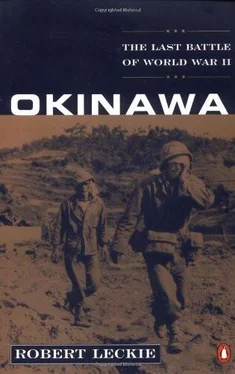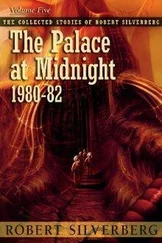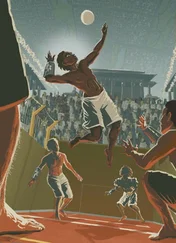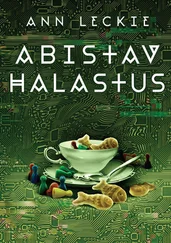Isamu Cho, though not as rational as his rival Yahara, was at least as clever. Everywhere he seemed to see signs of enemy weakness, among them slackening aerial activity on April 10, as well as a Navy report of a reduction in the number of American ships in the Hagushi Anchorage. The calculating Yahara could have explained the first as a result of the same cloudy, rainy weather that discomfited everyone on the island—Cho included —and the second as caused by the visible stream of unloaded enemy ships sailing back to base for reloading and return. But Cho was then at his argumentative best, and over the precise but uninspiring protests of the unhappy Yahara, General Ushijima ordered a “powerful” counter-attack for the night of April 12-13.
Cho’s plan was for massive infiltration of almost the entire east-west front of the U.S. Seventh and Ninety-sixth Divisions. Three battalions of the Japanese Twenty-fourth Division would strike the Seventh on the east (or right of the American line), while three more from the Sixty-second Division would assault the battered Ninety-sixth. They would, of course, attack at night, a Japanese preference born of a desire to negate that dreaded American artillery. Breaking through the advance American units, the troops would then spread out in the rear area to a point four miles below Kadena Airfield. There they would take refuge in known caves and tombs. On the morning of April 13 they would emerge to slaughter Tenth Army’s rear-echelon troops, usually technical, headquarters, supply, and soldiers armed with nothing more lethal than a pencil. In the mêlée that would ensue, troops of both sides would be so hopelessly intermixed that the enemy would not dare to bring his artillery, air, and naval gunfire to bear. Meanwhile, other battalions remaining in place opposite the Seventh and Ninety-sixth would launch a furious attack intended to compel the Yankees to retreat, perhaps in such panic that they would be included in the general slaughter of the enemy’s rear echelon. Cho did not specify what would happen next, whether he intended actually to overrun the airfields as Imperial Headquarters had suggested, destroying installations and aircraft at will, or would be content merely with unnerving Buckner and disorganizing his two forward divisions.
With troops marching in drenching rain to their jump-off positions on April 12, Hiromichi Yahara became so apprehensive that he committed an act of insubordination so incredible that in any Western army it could not have ended otherwise than in a court-martial and dismissal—or perhaps worse. He went to Lieutenant General Takeo Fujioka, commander of the Sixty-second Division, and Lieutenant General Tatsumi Amamiya, commander of the Twenty-fourth, and actually persuaded them not to use three battalions each in the forthcoming operation, but only two. Not six, but four battalions would march to the plan of Isamu Cho.
Three flares burst over Kakazu Ridge during the early darkness of April 12. Two were red, the first signaling, “Commence artillery fire,” and the other, “We are attacking with full strength tonight”; and the third, shaped like a dragon, was for “Make all-out attack.” Almost instantly, at about 7 P.M., there fell on the Americans the heaviest Japanese artillery concentration of the war. On the sector of the battered Ninety-sixth alone about twenty-two hundred rounds exploded, while within five minutes another two hundred rocked the Seventh’s zone. Fortunately these Yankees with their painfully acquired battle savvy had dug their holes so “dry and deep” that few casualties resulted.
First to strike the Americans was the Twenty-second Infantry Regiment, which had marched for two days in pouring rain from its base on Oroku Peninsula just south of Naha. Loaded down with 110-pound packs and bags of food—an immense burden for these normally small soldiers—they had been told by their commander, Lieutenant Colonel Masaru Yoshida, to move in “a sinuous eel line,” and they did indeed feel more like fish than flesh as they lay huddled and shivering in cane fields to escape detection by enemy air. By nightfall they were already dispirited and bewildered, moving over unfamiliar terrain and with no precise plan. Instead of attacking en masse, they sought to infiltrate the Seventh Division’s sector in twos or threes or a squad or two, but got nowhere. One massed attack of about a hundred Japanese was riddled by GIs firing rifles and machine guns, killing about a third of them, wounding another third, and compelling all survivors to take refuge in a cave.
The assault on the Ninety-sixth Division’s front, however, was much heavier, better organized, and of longer duration—personally directed as it was by General Fujioka. Guileful and stealthy as always, a long column of Japanese sought to penetrate the Ninety-sixth’s position by pretending to be GIs marching openly down Highway 5 in a column of twos. Twenty of them slipped past scrutiny until the Americans, realizing that they were not friendly troops on their flank, opened fire with all weapons. Those who survived scurried for cover in caves and tombs, but fifty-eight of their comrades were left dead on the field. Two more attacks were mounted against the Ninety-sixth, but both failed with heavy loss.
General Fujioka next tried to roll up his enemy with two companies following an artillery barrage against Kakazu Ridge. A small force staged a diversion around the western flank of Kakazu West while the main body tried to overrun the draw between that point and Kakazu Ridge. First to meet them was Pfc. William Daily at the trigger of a heavy machine gun in the draw. Unable to depress his gun enough to strike the approaching enemy below him, Daily began tossing grenades. Their explosions alerted Staff Sergeant Beauford “Snuffy” Anderson, holed up in a tomb with his light mortar section. Anderson left the tomb to hurl all of his grenades at the Japanese, and then emptied his carbine. Glancing about him, his eye fell on a dud enemy mortar. Seizing it he spiraled it football-style into the draw and was rewarded by an explosion and screams. Rushing back into the tomb he collected his own mortars, wrenched them from their casings, yanked out the safety pins, slamming the shell against a rock to release the setback pin, and spiraled this heavier and more lethal “football” into the draw. Again an explosion and screams … With this impromptu “passing attack,” Anderson sent all of his fifteen lethal footballs spinning into the darkness below, and by this effective exercise in Yankee battle ingenuity he stopped an entire enemy platoon. In the morning he counted twenty-five enemy bodies, plus seven abandoned knee mortars and four machine guns. For his bravery and quickness of thought, Anderson received the Medal of Honor.
Other Japanese who had infiltrated Kakazu West met the same end. When an enemy officer approached a BAR man and asked him if he were Japanese, the GI snorted, “No!”—and shot him dead, along with ten of his men following in single file. Soldiers of a company command post under attack in a tomb sallied forth to kill twenty Japanese. On the western slope of Kakazu West a single American machine gunner mowed down twenty-three more sons of Nippon.
Another enemy force nearly broke through the draw, until they were illuminated by star shells fired over the battlefield by American warships offshore, a technique developed at Peleliu and so successful that night actually could be turned into day. Silhouetted against the dark, the enemy was easily riddled and their attack broken in blood. Dawn revealed a draw covered with sprawling corpses.
General Cho’s desperation attack was also hurled back on Kakazu Ridge proper. When the Ninety-sixth’s heavy mortar crews were informed that about forty Japanese were threatening to overrun their battalion observation post, they decided to risk close support of their riflemen buddies up front. Hoping that their comrades would be safely below ground in pits and foxholes, they sent about eight hundred high-explosive shells humming skyward, to come plunging straight down with a horrible whistling noise that was the last sound many Japanese ever heard. Marine artillery also joined the bombardment, firing shells that drew a curtain of explosives around the endangered position. In the morning enemy dead were “stacked like cordwood” below.
Читать дальше










